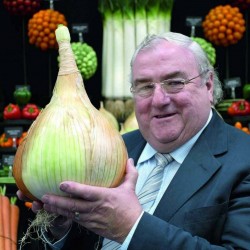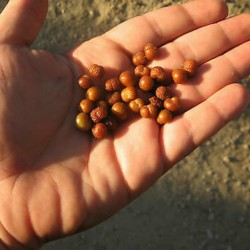

Kaffir Plum - South African...
Regular price
3,95 €
-15%
Ár
3,36 €
(SKU: V 191)
Seeds Gallery EU,
5/
5
<!DOCTYPE html>
<html>
<head>
<meta http-equiv="Content-Type" content="text/html; charset=UTF-8" />
</head>
<body>
<h2><strong><em><span style="text-decoration: underline;">Kaffir Plum - South African Plum Seeds (Harpephyllum caffrum)</span></em></strong></h2>
<h3><span style="color: #ff0000;"><strong>Price for Package of 3 seeds.</strong></span></h3>
<p>The Kaffir plum tree has a broad shady canopy and can reach heights of 15 meters. It has dark green sickle-shaped leaves that have a glossy appearance. An odd red leaf may be scattered throughout the foliage, which is key to its identification. White blossoms give way to loose clusters of oblong fruits. They are 3 cm long and first appear green but become bright red when ripe. Their interior resembles that of a mango with peachy-orange flesh surrounding a large seed. Fruit has a soft velvety texture and a tart acidity balanced by creamy notes of mango and passion fruit. While there is a small fruit to seed ratio, the skin easily comes away from the flesh, making for quick preparation.</p>
<p><strong>Seasons/Availability<br /></strong>Kaffir plums ripen through the summer and are forgeable in autumn. </p>
<p><strong>Current Facts<br /></strong>Botanically known as Harpephyllum caffrum, the Kaffir plum or South African Plum is a tropical evergreen in the cashew family. It produces small tart stone fruits that resemble miniature mangoes. The bark of the Kaffir plum tree is used to treat skin conditions and for making a natural mauve dye. The ornamental vegetation and drought resistant nature of the Kaffir plum make it a popular landscaping tree. </p>
<p><strong>Applications<br /></strong>The flavor of the Kaffir plum is similar to that of a tart mango and is compatible with other tropical flavors, such as, bananas, coconut, ginger, orange, lime, jalapeño and curry. Kaffir plums may be eaten raw or prepared as jam, jelly or chutney. Their tart nature make them perfect for a lemonade-style drink when combined with water and sugar. The juice can also be fermented into a rosé wine. </p>
<p><strong>Ethnic/Cultural Info<br /></strong>In eastern parts of South Africa the Kaffir plum tree is used in witchcraft ceremonies. It is believed that the roots can cleanse those afflicted with paralysis brought on by evil sorcery. </p>
<p><strong>Geography/History<br /></strong>The Kaffir plum is native to South Africa. It thrives in tropical and subtropical climates, but requires little water once established. It is regularly planted in southern California and other regions where rainfall is minimal. <br /><br /><strong></strong></p>
<table style="width: 100%;" border="0" cellspacing="0" cellpadding="0">
<tbody>
<tr>
<td>
<table style="width: 100%;" border="0" cellspacing="0" cellpadding="0">
<tbody>
<tr>
<td>
<p> </p>
<table style="width: 100%;" border="0" cellspacing="0" cellpadding="0">
<tbody>
<tr>
<td>
<table style="width: 500px;" border="1" cellspacing="0" cellpadding="0">
<tbody>
<tr>
<td colspan="2" valign="top" width="100%">
<p><strong>Sowing Instruction</strong></p>
</td>
</tr>
<tr>
<td valign="top" nowrap="nowrap">
<p><strong>Propagation:</strong></p>
</td>
<td valign="top">
<p>Seeds/Cuttings</p>
</td>
</tr>
<tr>
<td valign="top" nowrap="nowrap">
<p><strong>Pre-Treatment:</strong></p>
</td>
<td valign="top">
<p>soak ca. 24-48 h in lukewarm water</p>
</td>
</tr>
<tr>
<td valign="top" nowrap="nowrap">
<p><strong>Sowing Time:</strong></p>
</td>
<td valign="top">
<p>all year round</p>
</td>
</tr>
<tr>
<td valign="top" nowrap="nowrap">
<p><strong>Sowing Deep:</strong></p>
</td>
<td valign="top">
<p>ca. 2 cm</p>
</td>
</tr>
<tr>
<td valign="top" nowrap="nowrap">
<p><strong>Sowing Mix:</strong></p>
</td>
<td valign="top">
<p>Coir or sowing mix + sand or perlite</p>
</td>
</tr>
<tr>
<td valign="top" nowrap="nowrap">
<p><strong>Germination Temperature:</strong></p>
</td>
<td valign="top">
<p>ca. 22-25°C</p>
</td>
</tr>
<tr>
<td valign="top" nowrap="nowrap">
<p><strong>Location:</strong></p>
</td>
<td valign="top">
<p>bright + keep constantly moist, not wet</p>
</td>
</tr>
<tr>
<td valign="top" nowrap="nowrap">
<p><strong>Germination Time:</strong></p>
</td>
<td valign="top">
<p>ca. 3-6 weeks</p>
</td>
</tr>
<tr>
<td valign="top" nowrap="nowrap">
<p><strong>Irrigation:</strong></p>
</td>
<td valign="top">
<p>in the growing season richly water</p>
</td>
</tr>
<tr>
<td valign="top" nowrap="nowrap">
<p><strong>Fertilization:</strong></p>
</td>
<td valign="top">
<p>biweekly 0,2%ig or long-term fertilizer</p>
</td>
</tr>
<tr>
<td valign="top" nowrap="nowrap">
<p><strong>Pests:</strong></p>
</td>
<td valign="top">
<p>Spider mites > especially under glass</p>
</td>
</tr>
<tr>
<td valign="top" nowrap="nowrap">
<p><strong>Substrate:</strong></p>
</td>
<td valign="top">
<p>potting soil + sand or perlite</p>
</td>
</tr>
<tr>
<td valign="top" nowrap="nowrap">
<p><strong>Culture:</strong></p>
</td>
<td valign="top">
<p>bright at approx. 15-20°C + keep constantly moist</p>
</td>
</tr>
<tr>
<td valign="top" nowrap="nowrap">
<p><strong>Overwintering:</strong></p>
</td>
<td valign="top">
<p>Older specimens bright or dark at about 5-10°C and according to ambient temperature in larger intervals and only water in small quantities that the root ball not dries out completely.</p>
</td>
</tr>
<tr>
<td valign="top" nowrap="nowrap">
<p><strong>Note:</strong></p>
</td>
<td valign="top">
<p>Indoor suitable!</p>
</td>
</tr>
<tr>
<td valign="top" nowrap="nowrap">
<p><strong> </strong></p>
</td>
<td valign="top">
<p><br />Tuesday 20 August, 2013</p>
</td>
</tr>
</tbody>
</table>
</td>
</tr>
</tbody>
</table>
</td>
</tr>
</tbody>
</table>
</td>
</tr>
<tr>
<td> </td>
</tr>
</tbody>
</table>
<p> </p>
</body>
</html>
V 191

- -15%
- Új







